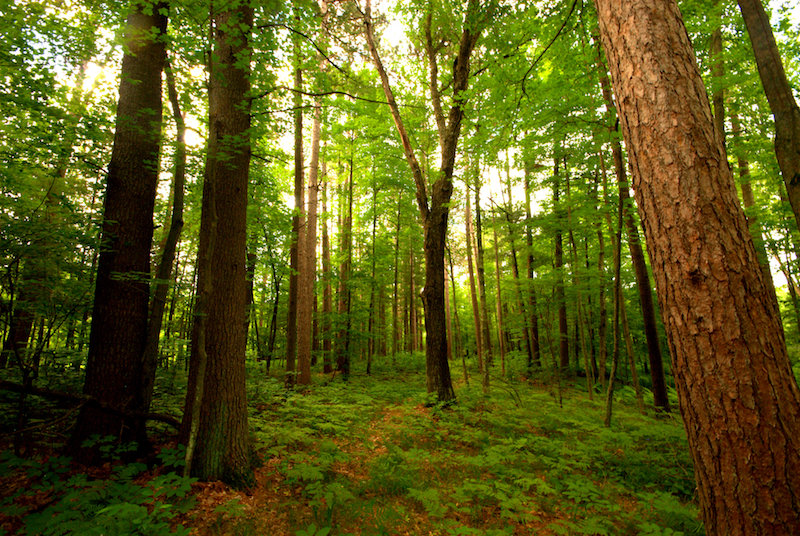Scientists Propose Restoring Forests to Fight Climate Change
New research shows that going back to nature through more environmentally conscious land use could help the U.S. could cut a fifth of its greenhouse gas emissions. Joshua Mayer/Flickr
Joshua Mayer/Flickr
U.S. scientists have found a new way to cut or offset 22 percent of the greenhouse gas emissions from American factory chimneys, car exhausts and power stations: better land use.
Their answer is to leave it to nature. What they identify as 21 natural climate solutions – better use of croplands, the restoration of forests and tidal wetlands, slowing the felling of timber and the containment of urban sprawl – could help limit global warming, slow climate change and reduce sea level rise for the nation that has over the last century emitted more greenhouse gas than any other country.
The most effective single action in a study launched by the US Nature Conservancy and 21 other institutions, and published in the journal Science Advances, would be to step up reforestation: this alone could absorb the emissions of 65 million passenger cars.
“One of America’s greatest assets is its land. Through changes in management, along with protecting and restoring natural lands, we demonstrated we could reduce carbon pollution and filter water, enhance fish and wildlife habitat, and have better soil health to grow our food — all at the same time,” said Joseph Fargione, director of science for the Nature Conservancy, who led the study.
New Thinking—and Old
“Nature offers us a simple, cost-effective way to help fight global warming. In combination with transitioning to zero carbon energy production, natural climate solutions can help protect our climate for future generations.”
Paradoxically, some of the solutions rely not on new thinking, but on old. If areas of the US that were forested before the European settlers arrived were returned to woodland, the land could absorb 381 million tonnes of carbon dioxide equivalent. If commercial foresters extended the cycles of logging and improved forest management practices, they could effectively save 267 million tonnes a year of CO2.
Around 4,000 square kilometers (1544.409 miles) of grassland is converted to cropland in a year: the act of ploughing releases 28 percent of the soil carbon to the atmosphere. The scientists reckon that at least 52,000 square kilometers (20077.312 miles) of marginal or unprofitable cropland could be restored to natural grassland or prairie.
Right now, 27 percent of US tidal wetlands are cut off from the ocean and being flooded by river water: accordingly, these release huge quantities of the potent greenhouse gas methane. All it would take to stop this would be to restore the twice-daily marine inundation: reconnection with the ocean, sometimes just by a culvert under a road, would save 12 million tonnes of CO2 equivalent a year.
The researchers identified just 10 of their 21 possible solutions that together could reduce emissions by more than a billion tonnes of carbon dioxide equivalent a year.
That more efficient use of land is a net benefit is not news: researchers have repeatedly argued that world food security is consistent with forest restoration, and that forests left untouched are of greater overall economic value than cleared land, and that considered changes to farming practices could both deliver more food and leave farmers better off.
But, ironically, efforts to promote natural climate solutions in the US get only 0.8 percent of public and private climate finance, even though these could provide 37 percent of the climate mitigation needed by 2030. The scientists argue that if the US is to commit to the Paris Accord of 2015, to contain global average warming to 2°C or less (35.6 °F)above the levels for most of human history, then natural climate solutions make a promising start.
Lynn Scarlett, a former acting secretary of the US Department of the Interior and now at the Nature Conservancy, said: “This study provides good news that making investments in nature will make a big difference, while offering the potential for new revenue to farmers, ranchers, foresters and coastal communities at the same time.”
Your support matters…Independent journalism is under threat and overshadowed by heavily funded mainstream media.
You can help level the playing field. Become a member.
Your tax-deductible contribution keeps us digging beneath the headlines to give you thought-provoking, investigative reporting and analysis that unearths what's really happening- without compromise.
Give today to support our courageous, independent journalists.






You need to be a supporter to comment.
There are currently no responses to this article.
Be the first to respond.